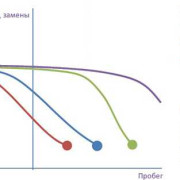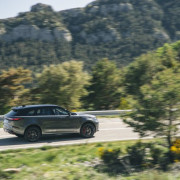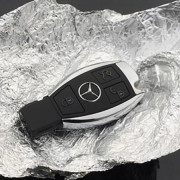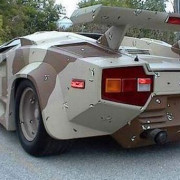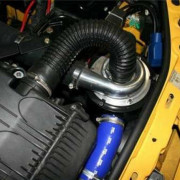Обзор buick riviera (все поколения): винтажный стиль
Содержание:
- Пятое поколение (1977-1978)
- BUICK RIVIERA ROOTS
- Hi-Rakers Version
- Second generation (1966–1970)
- Третье поколение (1971-1973)
- Third generation (1971–1973)
- История создания и развития
- BOATTAIL AFTERMATH
- Fourth generation (1974–1976)
- Функционал сенсорного дисплея на автомобиле Buick Riviera
- Первое поколение (1963–1965)
- Origin of the name
- Fifth generation (1977–1978)
- Sixth generation (1979–1985)
Пятое поколение (1977-1978)
Конструкторы Buick в новом поколении 1977-го года решили уменьшить габариты «Ривьеры», поставить ее на В-платформу меньших размеров.
В таком исполнении колесная база составила 294,0 сантиметра, при общей длине машины, равной 5,54 метра.

Общий снаряженный вес Buick Riviera уменьшился до 300 килограмм, а вместо старого двигателя был установлен 5,7-литровый «бензинник» V8, демонстрирующий мощность в 155 «скакунов».
Кроме того, топовые комплектации снабжались 170-сильным «сердцем» от Oldsmobile, объем которого составлял 6,6 литра.
Продажи этого авто показали весьма скромные цифры как в 77-м, так и в 78-м, а потому в 1979-м на рынке появилась новинка на Е-платформе.
Сегодня модели 1977 и 1978 годов считаются большой редкостью, поскольку они производились всего два неполных года.
Следует также отметить, что в 1978-м году был выпущен специальный юбилейный пакет под названием «LXXV», который приурочили к 75-летию бренда Buick на автомобильном рынке.

Машина была отделана кожей и хромом внутри, и окрашена особой черной краской с серебром.

BUICK RIVIERA ROOTS
As we have seen, the first four-seat Ford Thunderbird, launched in 1958, revealed a lucrative market for stylish “personal cars” aimed at buyers looking for something with more dash and distinction than a normal sedan or coupe. Mechanically, the “Square Bird” was unexceptional, but it struck a chord and many affluent buyers clutched the new T-Bird to their collective breasts.
The 1963 Buick Riviera was based on a design by stylist Ned Nickles, although the sharp-edged roofline was suggested by a Hooper-bodied Rolls-Royce that GM styling VP Bill Mitchell once saw through a London fog. Bill Mitchell later said the original Riviera was one of his favorite designs.
Given the Thunderbird’s great popularity, it took GM and Chrysler a surprisingly long time to respond in kind. GM had dabbled with personal cars back in the early fifties, with the Buick Skylark, Oldsmobile Fiesta, and early Cadillac Eldorado, but those were limited-edition image-builders and were far less profitable than the Thunderbird.
The early sixties brought a number of dressed-up versions of standard bodies, like the Oldsmobile Starfire and the first Pontiac Grand Prix, but GM’s first direct response to the T-Bird was the 1963-1965 Buick Riviera. Swift, elegant, and reasonably agile for a big American car, the Riviera made a credible effort to blend luxury and genuine sporting flair. Although it failed to outsell the Thunderbird, the Riviera accounted for over 100,000 sales in three years, enough to earn it a permanent place in the Buick line-up.
Hi-Rakers Version
|
The Hi-Rakers 1971 Buick Riviera has come out in the following 1:64 scale versions:
| Col # | Year | Series | Color | Tampo | Base Color / Type | Window Color | Interior Color | Wheel Type | Toy # | Country | Notes / Variations | Photo |
|---|---|---|---|---|---|---|---|---|---|---|---|---|
| 102 | Hi-Rakers2/5 | Metalflake Purple | Yellow & Purple tampos on sides | ChromePlastic | Yellow tint | Chrome | PR5 | J3428 | Malaysia | Features a lifted 4WD look | ||
| 216/247 | Thrill Racers — Prehistoric1/5 | Metalflake Green | Yellow «71», Yellow, Green Orange & Purple design | YellowPlastic | Orange tint | Yellow | Yellow OR6SP | V5520 | Malaysia | Lifted 4×4 featureBase code(s): | ||
| 216/247 | Thrill Racers — Prehistoric1/5 | Red | White «71», Yellow, Light Blue & Dark Blue design | ChromePlastic | Blue tint | Chrome | Chrome OR6SP | V5579 | Malaysia | Base Code(s): E02 |
Second generation (1966–1970)
The Riviera was redesigned for the 1966 model year. It retained its cruciform frame, powertrain, and brakes, but it wore a longer, wider, more curvaceous body, a shell it now shared with the Oldsmobile Toronado, and, a year later, with the Cadillac Eldorado. A notable styling point was the absence of vent windows, a feature GM had introduced with a flourish in the 1930s. Headlamps remained concealed, but they now pivoted up above the grille when not in use. Unlike the Toronado and Eldorado, the Riviera retained a conventional rear wheel drive layout. It was now some 200 pounds (91 kg) heavier, so acceleration with the unchanged 425 engine was slightly slower. The Gran Sport package remained available as an option. Rear seat belts were optional. AM/FM radio is optional.
Inside, the four-place cabin with front and rear bucket seats and center console was replaced by a choice of bucket seats or conventional bench seats as standard equipment, making the Riviera a full six-passenger car for the first time. Optionally available was a Strato-bench seat with armrest or Strato bucket seats with either a short consolette or a full-length operating console with a «horseshoe» shaped floor shifter and storage compartment. Both the buckets and Strato-bench seat were available with a reclining seat option for the passenger’s side. Sales for 1966 rebounded to 45,308, a new record.
The most significant change for 1967 was the adoption of Buick’s entirely new V8 of 430 cu in (7.0 L) displacement, 360 horsepower (270 kW) and 475 lb·ft (644 N·m) of torque to replace the old 425 «nailhead». The new engine, with greater power and torque on hand, represented a significant performance improvement. Gasoline mileage improved slightly with the new engine, though it remained gas-thirsty compared to modern cars. Powerful Disc brakes with Bendix 4 piston calipers became optional for the front wheels but most Riviera continued to be ordered with Buick’s aluminum brake drums which were almost as good. Cosmetically, changes were few, and were limited to the addition of a wide, full-width, center-mounted horizontal chrome grille bar that stretched over the headlight doors and outboard parking lights. Sales eased to 42,799 for the 1967 model year. The Riviera had full instrumentation.
1968 models had reshaped front and rear loop-type bumpers that encased the vehicle’s (recessed crosshatch) grille and tail lamps, respectively. Hidden wiper arms were also new. Federally-mandated side marker lights were of an inverted trapezoidal shape on the lower leading edges of the front fenders. Rear marker lights were circular. The interior was restyled and, unlike the 1966-67 models, shared its instrument panel with the other full-size Buick models. There were very few mechanical changes in 1968 but the transmission lost its variable pitch torque converter. Sales set another new record in 1968, as 49,284 units were sold.
For 1969, minor styling changes took place. Grilles changed from the crosshatch pattern seen in ’68 to a pattern of finely-spaced, slim vertical bars overlaid by two wider horizontal bars, which jutted forward at their inboard edges. Front marker lights became far shorter, and square in shape. Chrome side trim was revised, as well. At the rear, the reverse lights were move from the rear bumper into the ’69 Riviera’s new 3-section tail light lenses. Sales for 1969 improved again, to 52,872. A new front suspension system was used.
The 1970 Riviera was restyled. Exposed quad headlamps were nearly flush-mounted, while the new front bumper wrapped around and over the new vertical bar grille, set between the headlamp pods. A newly optional side trim feature accented the large coupe’s flowing lines. Skirted rear wheels became standard, with exposed wheels an option. At the rear, a new rear bumper/taillight motif was seen. The engine was upgraded to 455 cu in (7.46 L), the largest engine Buick offered to date, rated at 370 horsepower (280 kW) gross, 245 hp (183 kW) net, and over 500 lb·ft (680 N·m) of torque. Despite the fact that ’70 sales dropped to 37,366, the second-generation Riviera proved more successful than the first, with 227,669 units sold over five seasons.
Третье поколение (1971-1973)
Для моделей Riviera, которые начали выпускаться с 1971-го года конструкторы радикально изменили дизайн кузова.
Новые автомобили получили динамически-суженную кормовую часть и плавные линии. В разработке интерьера участие принимал будущий глава дизайнерского отдела корпорации «Ниссан».

В процессе разработки «Ривьера» получила увеличенную на 76 миллиметров колесную базу, стала тяжелее на 55 килограмм и обзавелась модернизированным силовым агрегатом, мощность которого достигала 255 «пони».
С места до сотни машина разгонялась за 8,1 секунды. Важным новшеством стало появление пробуксовочной системы, которая отлично противодействовала пробуксовке колес во время разгона по скользкой дороге.
Несмотря на яркий вид и современную «начинку», продажи автомобиля стали снижаться.
Эта тенденция сохранилась и в 1972-м, когда на автомобиль в модификации Gran Sport начали ставить 250-ти сильный двигатель.

Еще через год (1973-й) этот мотор стал стандартным для всех модификаций.

Кроме того, появился новая вариация Stage One с более мощным силовым агрегатом на 260 «лошадок», хромированным фильтром системы охлаждения и самоблокирующимся дифференциалом, дополнительной звукоизоляцией и стабилизатором поперечной устойчивости.

Низкий уровень продаж и интереса автолюбителей заставили инженеров пересмотреть свое видение автомобиля, что в первую очередь касалось хвостовой части кузова.
Third generation (1971–1973)
The Riviera was radically redesigned for the 1971 model year with flowing and dramatic «boat-tail» styling. Designed under Bill Mitchell’s direction, it was penned by Jerry Hirshberg, future head of design for Nissan, mating the two-piece vee-butted fastback rear window, inspired by the 1963 Corvette Sting Ray split window coupe, to the Riviera’s platform. The design was originally intended for the smaller GM A platform, and the use of the Riviera’s body—expanded for 1971 by 3 in (76 mm) in wheelbase and more than 120 lb (54 kg) heavier—produced controversial looks. (Collectible Automobile ran an article about 1971-76 full-sized Buicks where one sketch design for their 2-door coupes which was rejected resembled the 1971-73 Riviera.) The 455 engine had a lower compression ratio to meet EPA emissions requirements, reducing power to 255 hp (190 kW), with 265 hp (198 kW) in the Gran Sport. Performance remained reasonably brisk, with a 0-60 time of 8.1 seconds for the GS, but the Riviera’s sporty image was rapidly fading. One noteworthy advance was Buick’s Max Trac, a traction control system that prevented wheelspin during acceleration on slippery surfaces. The 1971 Riviera also features GM’s «Full-Flo» ventilation system and two large deck lid louvers are prominent on the trunk lid. (Unfortunately, under certain conditions a vacuum was created that sucked rain and exhaust back into the car and the «Full-Flo» ventilation was redesigned and the louvers were removed from trunk lid for the 1972 model year.)
Despite these features, Riviera sales for 1971 dropped to 33,810, the lowest to date. The 1972 Riviera was little changed, with the 455 engine switching to net power ratings, 225 hp (168 kW) or 250 hp (190 kW) with the Gran Sport, although the actual drop in net power was only 5 hp (3.7 kW). Sales remained moribund at 33,728. For 1973, the 250 hp (186 kW) engine became standard, with 260 hp (190 kW) with the Stage One package, which also included a limited slip differential and a chrome-plated air cleaner. The «Gran Sport» package was still available as a separate option package consisting of a ride-and-handling package that included a rear stabilizer bar, JR78-15 whitewall steel-belted radial tires, a specially tuned «radial roadability» suspension, additional sound insulation and special «Gran Sport» badging. The 1973 model is also distinguished from the 1972 models in that the rear «boat-tail» is somewhat less pronounced than on the 1972 model, resulting in a flatter rear bumper.
1971 mint green Rivieras can be extensively seen in the television show Due South, as they are an obsession of lead character Detective Vecchio.
История создания и развития
Следует отметить, что всего в мире было продано более миллиона машин «Бьюик Ривьера» различных генераций, что само по себе является существенным достижением и показателем популярности данной модели.
Имя автомобилю выбрали в соответствии с его внешним видом, который, по мнению конструкторов, абсолютно соответствовал богатству, роскоши и очарованию Французской Ривьеры тех лет.
Впервые оно появилось в линейке «Бьюика» еще в 1949-м году и принадлежало двухдверному хардтопу, который преподносился не иначе как «потрясающе умный».
Buick Roadmaster Riviera наряду с моделями Oldsmobile 98 Holiday и Cadillac Coupe de Ville стали первыми в истории купе, обладающими подобным дизайном кузова и запущенными в производство. Именно эти авто последующие тридцать лет были на пике популярности.
В период 1951-53 годов «Ривьерой» величали четырех дверный суперседан Buick Roadmaster, который производился на удлиненной колесной базе.
Еще позже, в 1955-м «Бьюик» представил первый в мире хардтоп Riviera с четырьмя дверьми, который выпускался серийно в двух версиях Special и Century.
В целом, многие премиум-хардтопы назывались «Ривьерой» вплоть до 1963-го, пока это имя не закрепилось за персональным люксовым автомобилем от «Бьюик», предназначенным составить конкуренцию четырехместному Ford Thunderbird. И первой такой моделью стала XP-715 LaSalle.
BOATTAIL AFTERMATH
Although Lee Mays retired shortly after the 1973 boattail Riviera went on sale, his influence probably contributed to the boat-tail’s short lifespan. The 1974 Riviera was not yet all new, but the curved backlight and boattail stinger were gone, replaced with a sharp-edged new roofline with angular rear quarter windows reminiscent of the intermediate Colonnade coupes. A new 5 mph (8 km/h) rear bumper brought overall length to a daunting 226.4 inches (5,751 mm) — longer than the big Buick Electra 225 of a decade earlier — while the standard engine fell to 230 net horsepower (172 kW).
If Buick had hoped a more conservative look would boost Riviera sales, they were sorely disappointed. The OPEC oil embargo that began shortly after the 1974 Riviera’s introduction undoubtedly played a part in its dismal sales, which fell from more than 33,000 the previous year to just over 20,000. Nevertheless, it appears that buyers found little to love about the new styling; the 1974 Toronado outsold the Riviera by more than 30%, while the much more expensive Eldorado beat the Buick by about 2 to 1.
Even after buyers began to return to big cars in 1975-1976, Riviera sales remained low. The boattail Riviera may have been a polarizing design, but it had a clear-cut identity; the 1974-1976 models sacrificed much of that image without offering a coherent new theme to replace it.
The Riviera underwent several subsequent redesigns: It was downsized with the rest of Buick’s B-body cars in 1977 and in 1979 returned to the corporate E-body, belatedly adopting front-wheel drive like its Eldorado and Toronado siblings. The FWD Riviera was quite successful through 1985, but a further downsizing for 1986 once again sent sales plummeting.
After a brief hiatus in the early nineties, the Riviera received a stylish redesign for 1995, but by then, the growing popularity of SUVs had largely decimated the coupe market. The Riviera expired for good in 1999. Buick has shown a number of styling studies for future Rivieras, but as of this writing, there has been no word of a new production model.
Fourth generation (1974–1976)
Although carrying over the same platform, mechanicals, and some body panels seen on the «Third Generation» Riviera, Buick replaced its distinctive ‘boat tail’ roofline with a more conventional-looking «Colonnade» treatment. This turned the car from a hardtop coupe into a pillared coupe, as it featured wide B pillars and fixed quarter opera windows. A landau half-vinyl roof option was available. The car did retain its forward-jutting grille, albeit in slightly modified form. Thus modified, the car looked far less distinctive than its predecessors, and even its platform mates, the Oldsmobile Toronado and Cadillac Eldorado. The tamer-looking Riviera was no lighter, and its standard 455 V8 lost more power, dropping to 230 hp (172 kW) and 245 hp (183 kW) for standard and Stage One models, respectively. Max Trac was dropped from the option list after 1974 due lack of buyer interest. The revised styling did nothing for sales, which plummeted to 20,129 in 1974.
For 1975, the Riviera received an updated front fascia, which lost its forward-jutting theme through the redesign of the fiberglass front end cap. Quad rectangular headlights were mounted horizontally. The new vertical-bar grille echoed the «stand-up» theme that many GM cars of the day incorporated. Parking lights wrapped around the fender sides. The Stage One performance package was dropped for 1975, though the Gran Sport handling package would continue to be offered. The standard engine’s output dipped to 205 hp (153 kW). Sales for 1975 were 17,306.
Minor changes greeted 1976 models, the most notable of which was a new crosshatch grille insert. The Gran Sport handling package was replaced by an ‘S/R’ package that had similar sporting pretensions. Sales rallied slightly to 20,082 for 1976.
Функционал сенсорного дисплея на автомобиле Buick Riviera
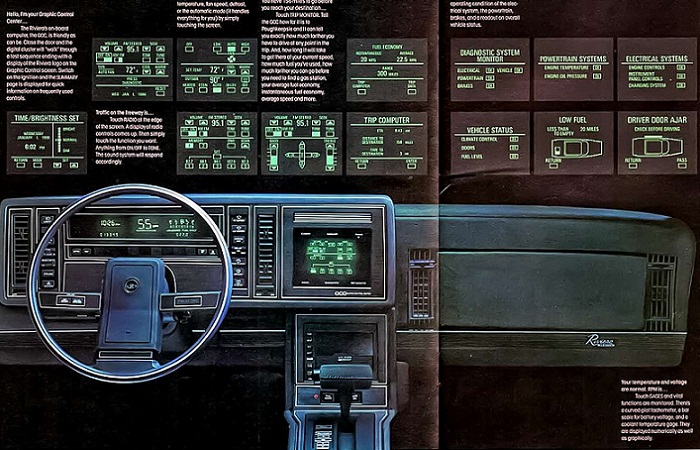
Многие современные владельцы автомобилей абсолютно не представляют свою жизнь без мультимедийной системы с сенсорным экраном. Однако раньше люди довольно легко обходились без нее.
Бортовой компьютер полностью контролировал климат-контроль и стереосистему автомобиля. Соответственно, все управление осуществлялось при помощи нажатия на сенсорный экран. В результате определенного рода манипуляциям с экраном человек мог легко переключать радиостанции приемника или же включить воспроизведение с аудиокассеты. Сенсорный экран позволял водителю регулировать скорость вентилятора, уровень температуры кондиционера, а также управлять обогревателями передних и задних окон.
На экран дисплея можно было вывести информацию о расходе топлива машины, давлении масла в системе и уровне заряда аккумулятора. Также бортовой компьютер мог проводить диагностику электроники автомобиля, трансмиссии и тормозной системы машины. После диагностики вся информация передавалась на экран.
Сенсорный экран Buick Riviera заменил множество различных кнопок и переключателей, которые присутствовали на транспортных средствах в 1980 годах. Подобного рода технология была инновационной и настолько впечатляющей, что модель Riviera заняла 4 место в конкурсе Motor Trend «Автомобиль года» в 1986 году.
Первое поколение (1963–1965)
Как часто происходит с автомобилями GM, первая «самостоятельная Ривьера» делила кузов с некоторыми другими моделями, выпускаемыми концерном.
Как и у стандартного на тот момент «Бьюика», она имела раму с поперечиной в форме креста, но слегка короче и уже. Длина составляла 530, а колесная база — 300 сантиметров, при весе в 1 813 килограмм.

В качестве двигателя использовались бензиновые агрегаты V8 объемом 6,57 и 6,96 литра.
Эти моторы агрегатировались сдвоенными турбинами и уникальной коробкой «автомат».
Кроме того, в авто были установлены тормоза с гидроусилителем и 12-дюймовыми колодками. Рулевое управление также имело гидроусилитель.
Модель дебютировала в октябре 1962-го с двигателем мощностью 325 лошадиных сил, а более мощный 340-сильный вариант появился в декабре, после чего Riviera получила звание лучшего автомобиля с прекрасным сочетанием скорости и комфорта.
Отметим, что новинка была способна разогнаться до «сотни» за 8 секунд и демонстрировать максимальную скорость в 185 км/час, расходуя 17,8 литров топлива на 100 километров пути.
Салон авто был рассчитан на четверых пассажиров, передние сидения в форме ковша разделяла консоль с рычагом коробки передач, а приборная панель имела скрытый отсек для хранения небольших вещей.

Обивка интерьера была тканево-виниловой, но за дополнительную плату можно было заказать машину с кожаным салоном, который предлагался как дополнительная опция. Оформление также включало ореховые вставки на некоторых панелях.
Кроме того, предусматривалась регулировка рулевого колеса и водительского кресла, кондиционер и стеклоподъемники, а также белые ободки шин и радиоуправляемое внешнее зеркало.
В 1964-м году впервые начали использовать стилизованную литеру «R», ставшей в дальнейшем неотъемлемым элементом дизайна, по которому можно было идентифицировать модель как «Riviera».
В итоге, автомобиль этого поколения был продан в количестве 112 244 экземпляра, а сам он стал единственным достойным конкурентом для Thunderbird.

Сегодня эта модификация является весьма редкой и очень цениться среди коллекционеров.

Renault Trafic, обзор, поколения, технические характеристики, конкуренты
Origin of the name
The Riviera name first entered the Buick line in 1949 as the designation for the new two-door pillarless hardtop, which was described in advertising as «stunningly smart.» The Buick Roadmaster Riviera coupe (along with the Cadillac Coupe de Ville and Oldsmobile 98 Holiday coupe) constituted the first mass production use of this body style, which was to become extremely popular over the next 30 years. Buick would add a 2-door Riviera hardtop to the Super the following year, the Special in 1951 and the Century upon its return, after a 12 year absence, in 1954.
From 1951 to 1953 the «Riviera» designation was also used on long wheelbase versions of the 4-door Buick Roadmaster and Super sedans (a long wheelbase sedan was offered on both lines in 1950 but they were not called Rivieras). The 1951-53 Buick Roadmaster and Super 4-door Riviera sedans featured more standard features, more plush interior trim and, most significantly, a wheelbase (and overall length) that was 4 inches (102 mm) longer than a regular Buick Roadmaster or Super 4-door sedan. The 1951-52 Buick Super 4-door Riviera sedan was still 0.75 inches (19 mm) shorter in wheelbase and length than the regular Buick Roadmaster and 4.75 inches (121 mm) shorter than the Roadmaster 4-door Riviera sedan. In 1953, with the move from the Fireball straight-eight to the more compact Nailhead V8 engine, the Roadmaster and Super 4-door Riviera sedans became the same length.
In the middle of the 1955 model year Buick and Oldsmobile introduced the world’s first mass-produced four-door hardtops, with Buick offering it only on the Century and Special models, and the «Riviera» designation was also applied to these body styles. Four-door Riviera hardtops were added to the Roadmaster and Super lines at the beginning of the following model year. However, since it was a body style designation and not a model, the Riviera name did not usually appear on the car.
In 1959, Buick became much more selective in applying the Riviera name. From then until 1963 it only was used to denote a premium trimmed 6-window hardtop style which it initially shared exclusively with Cadillac (the Oldsmobile 98 would receive it in 1961) and was available only on the Electra 225. The last usage of the term «Riviera» to describe hardtops was 1963, as the formal designation of the #4829 Electra 225 Riviera four-door hardtop. Coincidentally, this was the same year the Riviera would become a separate model in its own right.
Fifth generation (1977–1978)
Buick downsized the Riviera for 1977 (unlike Cadillac and Oldsmobile, which downsized a couple of years later), sharing the new smaller GM B platform. While the other E-bodies were front wheel drive since 1966 (1967 for Cadillac’s Eldorado), the Buick E platform used a B-body undercarriage (along with the cruciform frame of pre-1965 GMs for the 1966-70 generation). All B-bodies (including C and D platform GM RWDs) were downsized for the 1977 model year which prompted the short-lived 1977/78 generation.
It was, in most respects, a Buick LeSabre coupe with unique styling (with quarter windows mimicking the 1975-78 Cadillac Eldorado). Unlike its LeSabre counterpart, the front fascia is vertical as opposed to slanted. It was reduced to a wheelbase of 115.9 in (2,940 mm), down 6.1 in (150 mm), and an overall length of 218.2 in (5,540 mm), down 4.8 in (120 mm). Weight dropped some 660 pounds (300 kg). The 455 was gone, replaced by a 350 cu in (5.7 L) Buick V8 engine with 155 hp (116 kW) or Oldsmobile-built 403 cu in (6.60 L) with 185 hp (138 kW). California models had a 170 hp (127 kW) Oldsmobile 350.
Sales were up modestly to 26,138 for 1977 and then fell to 20,535 for 1978, although this was strictly a stopgap model until the all-new E-body cars would be ready for 1979. To date, 1977 and 1978 Rivieras are considered a rare find since it was only produced for two model years on the downsized GM B platform before the 1979 redesign on the FWD E-platform (there are two reasons why the B-platform was used — the existing 1976 B-platform was phased out for the downsized variant where RWD E-platform vehicles were produced on the B-chassis. Buick could have continued production although the frame stamping facilities and undercarriage/chassis components were being retooled in late 1976 for downsized B-platform production where the FWD E-platform did not downsize since they were produced on a separate assembly line.
Also, with Buick dropping its 455 V8 after 1976, continuing the ’77-78 Riviera on the old E-body platform would have forced Buick to either downsize its engine compartment to their 350 V8, which was too small and underpowered for a 5,000-pound car — or «import» larger engines from other GM divisions including 400s from Chevrolet and Pontiac, Oldsmobile’s 403 or Cadillac’s 425 — each of which would have limited sales and production as each division gave first priority to its own vehicles before selling engines to other divisions.
Buick Riviera: 75th Anniversary Package
For 1978, a special «LXXV» edition was released to commemorate Buick’s 75th anniversary on the market. Production total was 2,889 and included special silver & black paint with gray leather seats with black trim, brushed chrome trim, deep pile carpeting and special LXXV name plates.
Sixth generation (1979–1985)
1979 saw the debut of the first front wheel drive Riviera on a trimmer, 114 in (2,900 mm) wheelbase, once again sharing its mechanical design and platform with the Cadillac Eldorado and Oldsmobile Toronado. The Olds 403 and Buick 350 were dropped, but the Olds 350 remained, as did a new turbocharged Buick V6 of 231 cu in (3.8 L) displacement with 185 hp (138 kW). The Riviera became Motor Trend’s Car of the Year. Sales more than doubled, to 52,181 for 1979 and 48,621 for the very similar 1980 models.
1981 saw the Turbo renamed T-Type and the demise of the 350 engine in favor of the Oldsmobile-built 307 cu in (5.03 L) with 140 hp (104 kW) (phased in during the 1980 MY). The standard engine was now Buick’s 125 hp (93 kW) 252 cu in (4.13 L) V6, and a new option was an Oldsmobile diesel engine with a mere 105 hp (78 kW). offered through 1985. 1982 also saw the first-ever Riviera convertible, although relatively few were built, owing to very high prices-US$23,944. Riviera convertible was available in only two color choices-white or red firemist with the only interior color of red leather. A turbocharged Riviera convertible was chosen to be the pace car at the 1983 Indianapolis 500, although most convertible Rivieras had the V8 engine, which saw an increase in rated SAE net horse power to 150 for both convertibles and coupes fitted with it from 1982 through the 1985 model year.
Overall sales made the 1980s Riviera a great success, reaching 65,305 for the 1985 model year.

